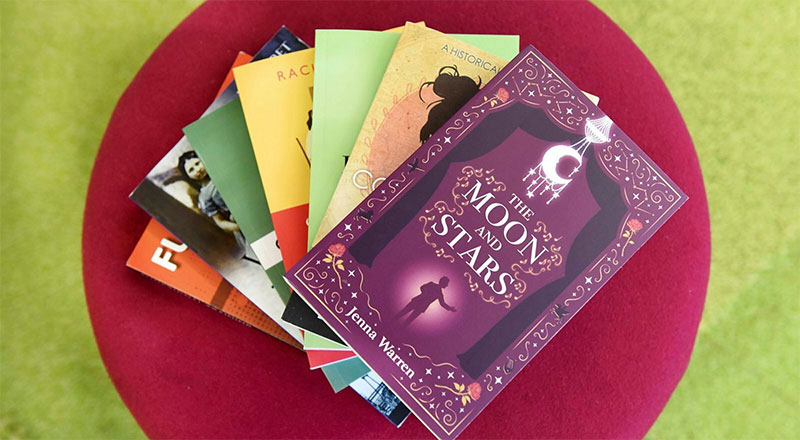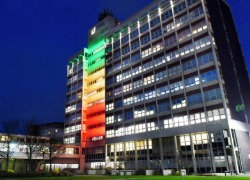Bisexual representations in the media
Ah, autumn is upon us. And what better time than this liminal season to celebrate and amplify bisexual representation? Tuesday 23 September 2025, is Bi Visibility Day. As the ‘visibly bi’ co-chair of Teesside’s LGBTQ+ Focus Group, here are some recent shows and books I’ve enjoyed which feature bi+ characters.

TV
Hacks A colleague recommended Hacks to me a few years ago, but it’s only recently that I ended up bingeing multiple seasons. The plot follows a struggling young writer, Ava, who is paired with a legendary (but stale) comedian, Deborah. As well as being laugh-out-loud hilarious, Hacks provides exceptional representation. Ava, who is bisexual, explains her different romantic and sexual attraction to different genders in a matter-of-fact, accessible way. We also see her in a sapphic relationship (very rarely do we see bisexual characters in same-sex relationships on screen). In a later season, she talks to Deborah about how compulsory heteronormativity can prevent lots of people from discovering their queerness until later in life. However, the whole conversation is a lot more gentle and subtle than how I’ve phrased it here, and I was genuinely moved. Ava is a complex, flawed character (as are most in Hacks), and it is joyful to see such a nuanced representation of bisexuality. Hacks has a running gag about bisexuals being the ‘elite few.’ After spending most of my life only ever seeing bisexual characters being made the butt of the joke, I’ll take it!
Heartstopper Given the astronomical success of this adaptation of Alice Oseman’s graphic novel, you may think it’s not worth mentioning. Still, I think Nick ‘I’m bisexual, actually’ Nelson deserves a proper shout-out! Again, it’s rare for bisexual characters to be depicted in a relationship with someone of the same gender, so Heartstopper’s Nick is providing some essential representation. Moreover, and very naturally, Nick’s character challenges stereotypes of queer men. He is portrayed as strong, popular, and athletic. Historically, this type of character would be written to act out in toxic displays of internalised queerphobia. In Nick, however, we see someone whose emotional intelligence and resilience are just as impressive and valuable as his physical prowess. Nick is someone who consistently displays enormous empathy and curiosity about his own inner life as well as those of his friends and partner. Nick offers young viewers not just valuable representation of bisexuality, but also a model for navigating complex feelings and situations with care and grace.
Why we need diverse representation in all types of media.
Books
Irish author Naoise Dolan includes bisexual characters in both Exciting Times (2020) and The Happy Couple (2023). In The Happy Couple, while protagonists Celine and Luke are viewed as a heterosexual couple by most of the world, both are bisexual and had previously been in same-sex relationships. This book explores how damaging it can be to make commitments based on societal expectations without properly examining our true feelings and motivations.
The protagonist (another Ava!) in Exciting Times often behaves problematically – but again, how refreshing to read about bisexuals who are complex, multi-layered human beings. Dolan herself is neurodivergent, so Ava’s complicated feelings about social interaction (and transaction) and relationship dynamics may reflect some of her own experiences in these areas. In Exciting Times, while it is not explicitly presented as such, there is significant representation of how bisexual people may experience romantic and sexual attraction differently depending on the gender of their partner. Just as in Hacks, this has the potential to be illuminating for many readers. I only learned about these spectrums of attraction on a podcast when I was in my early thirties, and it was such a significant experience I can still remember every detail of the park I was walking through, the temperature of the day, and uncanny sensation of suddenly feeling like someone had articulated something you had struggled to describe for your entire life. This is exactly why we need diverse representation in all types of media.
On that note, while all the media listed offers diverse and inclusive representation through other characters, all the bi+ characters are white. Send us your recommendations for diverse bisexual representation.
 Celebrating Black History Month
Celebrating Black History Month Physiotherapy apprentices qualify into hospital roles
Physiotherapy apprentices qualify into hospital roles  Teesside University to help deliver £11.5m AI-driven project
...
Teesside University to help deliver £11.5m AI-driven project
...